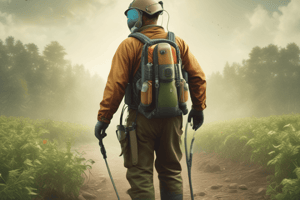Podcast
Questions and Answers
What does Economic Injury Level (EIL) refer to?
What does Economic Injury Level (EIL) refer to?
The smallest number of insects that will cause yield losses equal to the insect management costs.
What is the Economic Threshold Level (ETL)?
What is the Economic Threshold Level (ETL)?
The pest density at which management action should be taken to prevent an increasing pest population from reaching the economic injury level.
Which mode of damage is caused by insects attacking cultivated plants?
Which mode of damage is caused by insects attacking cultivated plants?
- Feeding
- Oviposition
- Vectors of diseases
- All of the above (correct)
Which of the following does NOT describe insects attacking stored products?
Which of the following does NOT describe insects attacking stored products?
Economic Threshold Level (ETL) is used to decide when to take action against pests.
Economic Threshold Level (ETL) is used to decide when to take action against pests.
What type of damage do venomous insects cause?
What type of damage do venomous insects cause?
What is the classification for pest that is always present in the field every season with high population?
What is the classification for pest that is always present in the field every season with high population?
List the two types of pests based on origin.
List the two types of pests based on origin.
Match the categories of insects to their descriptions:
Match the categories of insects to their descriptions:
Flashcards are hidden until you start studying
Study Notes
Insect Control Management
- Economic Injury Level (EIL): The point where the amount of insect damage is equal to the cost of controlling the insects.
- Economic Threshold Level (ETL): The point where insect populations are high enough to warrant control measures to stop them from reaching the EIL.
Modes of Insect Damage
- Plant Damage by Insects:
- Feeding (Phytophagy): Insects consume plant parts, causing damage to leaves, stems, roots, and fruits.
- Oviposition Damage: Insects lay eggs on or within plants, leading to plant tissue damage, death, or fruit drop.
- Disease Transmission: Insects act as vectors for plant diseases, spreading them from infected plants to healthy ones.
- Stored Products Damage:
- Destruction by Termites, Beetles, and Ants: Insects damage materials like wood and fabrics.
- Damage to Animal Fibers: Insects like dermestid beetles and clothes moths can damage furs, clothing, blankets, rugs, and upholstery.
- Stored Food Damage:
- Contamination by Tunneling/Feeding: Insects contaminate food with their presence and excrement, impacting quality and marketability.
- Damage to Man and Animals:
- Annoyance: Insects can cause annoyance through bites, stings, and secretions.
- Venomous Insects: Bees, wasps, and caterpillars can inject venom, causing irritation, swelling, pain, and even death.
- Parasitic Insects:
- Internal parasites: Live inside the bodies of humans or animals, causing irritation, tissue damage, and death.
- External parasites: Fleas and bed bugs can cause irritation through bites.
- Disease Transmission:
- Piercing-sucking insects: Vector diseases in plants, animals, and humans
- Houseflies and blowflies: Mechanically transmit diseases such as typhoid fever, cholera, and dysentery.
Insect Pest Classification
- Origin:
- Endemic Pest: Native to a specific region.
- Exotic Pest: Introduced from outside the local region.
- Population Dynamics:
- Key/Major Pest: Always present and abundant, causing significant damage.
- Potential/Minor Pest: Present at low populations, potentially becoming a major pest under favorable conditions.
- Occasional/Sporadic Pest: Migrate and cause significant damage when populations increase.
- Feeding Habits:
- Chewing Insects: Consume plant parts by chewing.
- Sucking Insects: Pierce plant tissues and suck out fluids.
- Boring Insects: Tunnel into plant tissues.
- Target Host/Plant Parts:
- Phytophagous (Herbivorous): Feed on plant parts.
- Zoophagous/Carnivorous: Feed on other animals.
- Entomophagous: Feed on other insects.
- Saprophagous: Feed on dead organic matter.
- Mycetophagous: Feed on fungi.
- Range of Host:
- Monophagous: Feed on only one species of host plant.
- Oligophagous: Feed on a few species of host plants.
- Polyphagous: Feed on many different species of host plants.
Studying That Suits You
Use AI to generate personalized quizzes and flashcards to suit your learning preferences.




